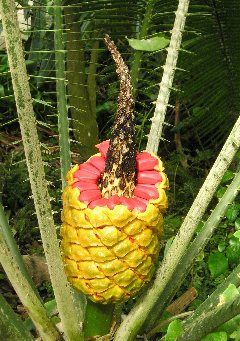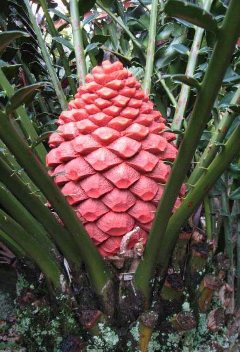As mid summer approaches, there are many cycad growers on “cone watch.” This is the time of year when cones begin to emerge in our gardens, if fortunate enough to have sexually mature plants. North of the equator cones can begin to emerge between June and August, and usually reach maturity within one to six months from full emergence.
For the intrepid few that choose to try to make their cycads productive and can locate both male and female cones maturing simultaneously, there is a small window of time in which you can assist in the production of viable seed. This involves what is commonly termed “hand pollination.”
Hand pollination can be achieved by delivering pollen into the interior void areas of the female cone when it becomes receptive. This process can be done with dry pollen or adding the pollen to water and pouring that mixture into the void channels of the female cone and repeating the process several times within the perceived period of receptivity at one to five day intervals.
It is important to note that caution should be taken not to use the water method if the female cone does not visibly show any exposed peduncle. The peduncle is the stem of the cone which attaches the cone and the caudex. See photo #1.

Female encephalartos Vilosus cone joined to the caudex by the peduncle - Wikimedia.org
If there is no peduncle showing, and the cone is tightly nested into and in close contact with the caudex or trunk of the female cycad, the use of water while pollinating should be cautiously undertaken or avoided altogether. See Photo #2.


Female encephalartos cone nested in caudex - nzpalmandcycad.org
My first attempt at pollinating any cycad was back in 1978, and I used the pollen/water method. The cone was nested closely to the caudex with no separation showing, i.e. no peduncle. The pollen/water mixture that I was pouring through the cone from the top down was trickling down through the cone and gathering in the top portion of the caudex. Well, as many of us know, standing water in contact with any portion of a cycad is usually a bad combination. After a few months as I was waiting for the cone to mature and break down (dehisce), the cone and the caudex began to turn to mush. My first lesson learned was that water as a pollen delivery system is OK, but the water mixture needs to have a way to drain away from the caudex and not be trapped in the caudex crown.
If the aforementioned condition exists as you are pollinating cones (the female cone is embedded in the nest of the top of the caudex), I would recommend one of the many techniques that involves the use of compressed air to deliver your pollen through your cone as a dry pollen delivery technique.
Grow and prosper,
Keith